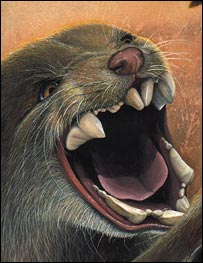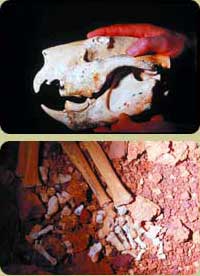
May 6, 2008

Thylacoleo carnifex
A sabre-toothed cat that sported the fearsome teeth of felines also had the body and gait of a bear, making it a “super-predator”.
So says a team led by Stephen Wroe at the University of New South Wales, Sydney, Australia, which found that the ferocious marsupial lion (Thylacoleo carnifex) shared the same super-predator body plan as Smilodon fatalis, North America’s ice age sabre-tooth cat.
Wroe and his team compared the skulls, teeth and body proportions of seven extinct mammalian predators with those of 22 living species, in a bid to better understand how the extinct animals behaved.
They found that five of the extinct species fell reasonably neatly into known predator groups. Two sabre-toothed cats sit well with modern- day felines, for instance, leading the team to conclude that they probably occupied a similar ecological niche. Smilodon and Thylacoleo didn’t fit into any group but they did have a lot in common.

Both had hyper-carnivorous teeth, designed to eat meat and nothing else. Smilodon famously had two massive upper canines, plus vertical, slicing teeth in its cheeks. While Thylacoleo lacked the enormous canines, it did have huge slicing teeth known as carnassials that would have scissored through hide and flesh. While living cats have broadly similar teeth, their bodies are very different. “The marsupial lion and Smilodon were built much more like bears,” Wroe says (Journal of Zoology , DOI: 10.1016/j.zool.2007.07.008).
Unlike cats, both extinct animals walked on the flats of their feet, had relatively short hind limbs and were much heavier, relative to their length. They also had relatively short and robust lower backs. All these features would reduce an animal’s agility but increase its stability. As Wroe says: “If you’re built like a brick shithouse, you’re much more stable but it’s much harder to move around or change direction.”
The combination of hyper-carnivorous teeth and a sturdy, strong body evolved to kill very large, cumbersome prey, the team thinks.
Thylacoleo, which weighed around 100 kilograms, probably killed animals of up to about a tonne, such as juvenile diprotodons, a giant wombat. Smilodon would have feasted on large bison and possibly even immature mammoths.
But while these fearsome predators would have terrorised their neighbourhoods, both were highly vulnerable to environmental change. Smilodon’s extinction, about 11,000 years ago, coincided with climate change and the arrival of people. Thylacoleo vanished about 30,000 years ago, in similar circumstances.
John Long, a palaeontologist at Museum Victoria in Melbourne, Australia, has studied Thylacoleo and says: “This paper provides the first hard mathematical evidence for interpreting the lifestyles and feeding methods of the biggest extinct mammalian predators we have known.”
Source: “Bearlike superpredator terrorised early humans; A sabre-toothed cat may have had the fearsome teeth of felines but it had the body and gait of a bear,” by Emma Young, 3 May 2008, New Scientist 15, volume 198; issue 2654.
About Loren Coleman
Loren Coleman is one of the world’s leading cryptozoologists, some say “the” leading living cryptozoologist. Certainly, he is acknowledged as the current living American researcher and writer who has most popularized cryptozoology in the late 20th and early 21st centuries.
Starting his fieldwork and investigations in 1960, after traveling and trekking extensively in pursuit of cryptozoological mysteries, Coleman began writing to share his experiences in 1969. An honorary member of Ivan T. Sanderson’s Society for the Investigation of the Unexplained in the 1970s, Coleman has been bestowed with similar honorary memberships of the North Idaho College Cryptozoology Club in 1983, and in subsequent years, that of the British Columbia Scientific Cryptozoology Club, CryptoSafari International, and other international organizations. He was also a Life Member and Benefactor of the International Society of Cryptozoology (now-defunct).
Loren Coleman’s daily blog, as a member of the Cryptomundo Team, served as an ongoing avenue of communication for the ever-growing body of cryptozoo news from 2005 through 2013. He returned as an infrequent contributor beginning Halloween week of 2015.
Coleman is the founder in 2003, and current director of the International Cryptozoology Museum in Portland, Maine.
Filed under Breaking News, Cryptotourism, CryptoZoo News, Cryptozoologists, Cryptozoology, Fossil Finds